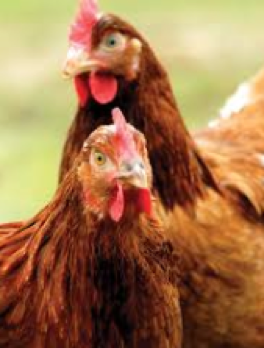Get a 24 hour weather forecast

An undeviating consequence of years of extensive scientific research has produced genetic lines of laying hens that have the potential to have excellent production traits. However, in order for these birds to reach their genetic potential, they must be supplied with the appropriate nutritional requirements and good welfare and management practices.
The first objective is to ensure that pullets develop the ability to eat feed in order to increase feed intake (FI) and subsequent growth potential and egg quality during the early and later stages of life. The feed offered to the pullets should be in crumb form and contain essential nutritive ingredients to enhance feed conversion to increased weight and subsequent egg production.
Amino acids, calcium and fatty acids are some of the critical dietary ingredient in a laying hen diet and must be maintained throughout its life. Amino acids promote protein deposition by converting feed utilization into increased growth in preparation for the laying period. Calcium is paramount for the growth of the medullary bone before the first ovulation and egg shell strength (Dacke et al., 1993). In conjunction with this, during the laying period, feed enriched with polyunsaturated fats is also desirable to increase FI and accordingly egg weight. However, although the nutritive content of a laying hen diet is a major factor influencing optimum growth performance and egg quality and quantity, the welfare and management of laying hens is also a crucial factor to consider.
Accomplishment in the laying period will be greatly influenced by the housing and management in the rearing period. Factors to consider are the breed, strain, colony size, temperature requirement, humidity, ventilation, lighting, platforms, perches, vaccination, biosecurity and record keeping. For example, backyard flocks need to be registered with the Department of Agriculture, Fisheries and Food in Ireland) and can these factors be achieved within a given housing system. According to the European Union (EU) Directive 1999/74/EC, three housing systems have been categorized. Alternative systems: This is a wide range of systems ranging from single tiered, multi-tiered aviaries to free range and backyard systems. Unenriched cage systems and enriched cage systems which enable hens to express some of their strong behavioural traits. Laying hens instinctively want to lay their eggs in a nest, perch, scratch, peck and have a dust bath on a littered floor that cannot be accomplished in unenriched cage systems.
It has also been observed that mortality in enriched cages is numerically lower than birds housed in unenriched cages (Sherwin et al., 2010). As a result, this has contributed to the prohibition of the use of unenriched cages within the EU from the 1st Jan 2012 with production there after only allowed in enriched cages or non-cage systems.
Once the housing system has been established, management practices include the code of practice for the welfare of laying hens implemented by the Farm, Animal Welfare Advisory Council (2011). The code contains the five freedoms, when laying hens are being reared regardless of the housing system. They ensure
The growing competition in the poultry industry requires effective layers to satisfy precise market requirements. Thus the nutrient content of feeds, the welfare and management system requirements need to work in collaboration in order to achieve this goal.